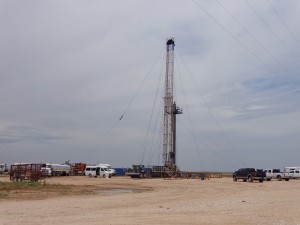Permian Basin, East Texas provide initial fields for new-design land rig

By Katie Mazerov, contributing editor
Globe Energy Services has designed a five-axle land rig providing quick rig-up/rig-down operations, a mast with 116 ft of clearance and an adjustable drilling floor. Two of the new Mustang 600 Class rigs have been deployed to the Permian Basin for unconventional oil shale wells, and a third is working in the Kilgore gas field in East Texas. A fourth rig will be added this fall, also to the Kilgore field. Opportunities to deploy additional rigs to the Bakken and Eagle Ford are possible as well, according to Johnny Slaughter, vice president of well services. “The taller mast is a key element of this new rig, because the operator can rig up and clear the wellhead control equipment from the ground instead of a ramp,” Mr Slaughter said.
Keeping the rig on the ground rather than on a platform enhances safety by providing more stability, he said. Transportation costs associated with moving a ramp to the well site also can be reduced. Further, Mr Slaughter noted that 96-ft to 112-ft masts on more conventional rigs may have problems clearing taller wellhead control equipment.
Automated features include a hydraulic floor and operator control platform that can be operated from two positions – 1 ft to 15 ft, and 15 ft to 30 ft. The floor allows the slips to be centered if the rig-up is slightly off to one side, eliminating the hazard of the slips catching on the floor while pulling pipe out of the hole, Mr Slaughter said.
Faster Trip Times
The rig has a 1 1/8-in. tubing line that provides line strength up to 276,000 lbs and allows blocks to be strung on six lines to reach maximum derrick and line rating, resulting in faster trip times. “If we need to go to 290,000 lbs, which is full derrick strength, we can put the blocks on eight strings,” Mr Slaughter said.
Another key design element is a safe mode air adjustor for reducing pressure on the air slips when entering or exiting the wellbore. “Historically, this has been a challenge because when there is too much pressure on the slips, rig operators have accidentally hit the slip control valve and dropped a joint or a stand of pipe in the hole,” he explained. “By reducing the air pressure, the slips won’t kick out, thus eliminating the hazard of dropping pipe in the hole.”
Mounted on a five-axle carrier, the rig maintains optimum highway weight and height tolerances, he said. “The rig is small enough to compete with other smaller rig designs for tight locations and shallow wells.”




